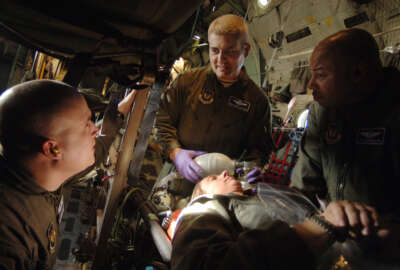
Army taking steps with DoD to rethink medical facility changes
The Army is working with the Defense Department on the possibility of slowing down the transfer of military treatment facilities to the Defense Health Agency, and...
The Army is working with the Defense Department on the possibility of slowing down the transfer of military treatment facilities to the Defense Health Agency, and the consolidation of those hospitals — especially in rural areas with large military bases.
The service’s concerns stem both from how quickly DoD will move military treatment facilities (MTFs) to a centralized agency, and the policy of mostly downsizing MTFs to require military family member and retirees to seek medical care from local civilian doctors. They also come from a plan to move military service medical research laboratories to the DHA.
“We are looking first at unique locations where the local economy might not be able to support or absorb the vast number of people on an Army installation” when it comes to rightsizing MTFs and transferring to DHA, Army Secretary Ryan McCarthy told reporters Wednesday at the McAleese and Associates Defense Programs Conference in Washington. “We’ll be starting there because they are your highest risk populations, and we are going to come back and see if that would mean a change to the model.”
DoD sent its MTF “rightsizing plan” to Congress last month. An estimated 200,000 military family members and retirees would lose their ability to get health care through military hospitals and clinics under the blueprint.
Read more Defense news
A total of 37 MTFs would downsize and stop seeing those civilians.
“What we found in our review is that many of these facilities do not have the type of patient case load, volume, acuity that we need for our providers to be proficient in what they do downrange,” Thomas McCaffery, the assistant secretary of Defense for health affairs told reporters on a conference call. “And so by limiting the scope of services, that will allow us to take some of those providers and place them at other MTFs that do have that direct match for their readiness requirements.”
McCarthy said his second concern is moving Army medical research and other facilities to DHA may hurt how the service brings in scientific talent.
“How does DHA budget? How do they develop personnel?” McCarthy said. “These are questions that we have because it’s going to inhibit us from recruiting people in the future. These people are extraordinary. Dr. Kayvon Modjarrad [director of Walter Reed Army Institute of Research’s emerging infectious diseases branch], who came to us from the World Health Organization. He was central to the vaccine for Zika. This is the guy running point on coronavirus. We’ve got to still be able to get these amazing people into our ranks so we can deal with these crises we face as a country.”
Federal News Network obtained an internal memo in January where McCarthy first expressed his worries about the transfer of MTFs.
“We are concerned about the lack of performance and planning of both DHA and Defense Department Health Affairs with respect to the MTF transition,” the Army wrote in the memo.
McCarthy asked to halt the transition until a detailed budget strategy and plan to transfer functions from the services is delivered.
“Like all mergers it’s about pacing,” McCarthy said in January. “You are bringing thousands of people and functions to one organization. Like all mergers and acquisitions there are cultural dynamics, there are synergies you try to achieve and if you do it too fast you’re going to make a mess. This is the healthcare of our soldiers and their families.”
McCarthy brought up challenges with Walter Reed Hospital during its consolidation.
“You were merging Walter Reed with Bethesda during the height of violence in the Iraq campaign and they made some terrible mistakes that affected the healthcare of wounded personnel,” McCarthy said.
Copyright © 2025 Federal News Network. All rights reserved. This website is not intended for users located within the European Economic Area.
Scott Maucione is a defense reporter for Federal News Network and reports on human capital, workforce and the Defense Department at-large.
Follow @smaucioneWFED






